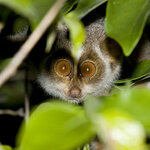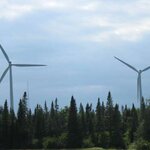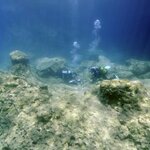Ecology & Zoology

Going, going, gone: wildlife like the loris are disappearing. Credit: N. A. Naseer, CC BY-NC-ND
By Paul Jepson, University of Oxford
Full marks to colleagues at the World Wildlife Fund and the Zoological Society of London for the Living Planet Report 2014 and its headline message which one hopes ought to shock the world out of its complacency: a 52% decline of wildlife populations in the past 40 years.
Over the summer I re-read Fairfield Osborne’s 1948 classic Our Plundered Planet – the first mass-readership environmental book that detailed the scale of the damage humanity wrought on nature.…

Some sharks are more 'gregarious' than others and have strong social connections while others are solitary and prefer to remain inconspicuous. That's not an exception, according to a new study, these notorious predators have personality traits.
Personalities obviously exist in many animals but they are usually defined by individual characteristics such as how exploratory, bold or aggressive an individual animal is. The paper in
the journal Behavioral Ecology and Sociobiology involved testing for social personality by recording the social interactions of groups of juvenile small spotted…

Certain bats may be approaching wind turbines after mistaking them for trees, according to a study, and that could be leading to disaster.
Propped up by government mandates and subsidies, both solar and wind energy have become more common and thus both have come under criticism. Solar panels are toxic for the environment and their efficiency drops quickly in real-world conditions while wind has been implicated in sleep issues in humans and environmental peril.
A new study led by U.S. Geological Survey scientist Paul Cryan used video surveillance cameras to watch bats for…

A bright orange poison dart frog with a unique call was discovered in Donoso, Panama, and described by researchers from the Smithsonian Tropical Research Institute and the Universidad Autónoma de Chiriquí in Panama, and the Universidad de los Andes in Colombia.
Andinobates geminisae is named for Geminis Vargas, "the beloved wife of [coauthor] Marcos Ponce, for her unconditional support of his studies of Panamanian herpetology."
Every new species name is based on a representative specimen. The specimen for this species was collected Feb. 21, 2011, in the headwaters of the Rio Caño, in…

Ryan Rykaczewski, an oceanographer and assistant professor at the University of South Carolina, is part of a team that are looking deep into the ocean's past, and they have shown that natural processes can cause dramatic year-to-year drops in fish populations and growth rates.
They also raise questions about whether human activities might be making those declines more frequent.
Upwelling means phytoplankton, the perfect 'sea food'
The focus of the research is the California current, which stretches from Washington state to the Baja peninsula and is one of a handful of coastal waters on…

Researchers in Indonesia are releasing the parasitic wasp Anagyrus lopezi in an attempt to save cassava crops from destructive mealybugs.
Credit:CIAT International Center for Tropical Agriculture .Rights information: http://bit.ly/otwhKG
By: Ker Than, Inside Science.
(Inside Science) -- Scientists today released 2,000 South American parasitic wasps in Indonesia as part of a project aimed at thwarting an invasive insect pest that is devastating the country’s cassava food crop.
The wasps were released into a small, confined field, enabling scientists to assess their performance under…

A glimpse of wild brumbies in the Snowy Mountains. Credit: Michael Tristram/Flickr, CC BY-NC-ND
By Don Driscoll, Australian National University and Sam Banks, Australian National University
When you think of horses in the Australia high country, you might imagine noble brumbies galloping out from snowgums across grassy peaks, tails and manes trailing like streamers.
But on a recent trip to the Snowy Mountains in Kosciuszko National Park we made a grim discovery about these denizens of the Australian psyche.
At Dead Horse Gap we encountered three brumbies standing calmly in the snow among the…

Man has domesticated animals for almost long as man has domesticated crops. In both cases, humans have engaged in genetic modification, selecting the best traits possible.
Because of that legacy, livestock such as sheep offer an intriguing way to examine adaptation to climate change, with a genetic legacy of centuries of selected breeding and a wealth of livestock genome-wide data available.
In a first-of-its kind study that combined molecular and environmental data, professor Meng-Hua Li et al., performed a search for genes under environmental selection from domesticated sheep…

Five families of notothenioid fish inhabit the Southern Ocean, the frigid sea that encircles Antarctica, manufacture their own "antifreeze" proteins to survive.
Their ability to live in the icy seawater is so extraordinary that they make up more than 90 percent of the fish biomass of the region.
They also suffer an unfortunate side effect: The protein-bound ice crystals that accumulate inside their bodies resist melting even when temperatures warm.
"We discovered what appears to be an undesirable consequence of the evolution of antifreeze proteins in Antarctic notothenioid fish,"…

Tropical rabbitfish have devastated algal forests in the eastern Mediterranean Sea and pose a major threat to the entire Mediterranean basin if their distribution continues to expand as the climate warms, according to a new study
in the Journal of Ecology.
The members of the team surveyed more than 1000 kilometers of coastline in Turkey and Greece, where two species of rabbitfish have become dominant since they moved into the region via the Suez Canal.
"The study identified two clearly distinct areas – warmer regions with abundant rabbitfish and colder regions where they were rare or absent…